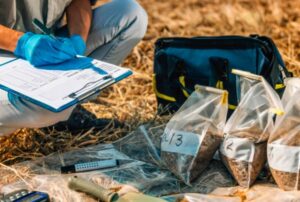Soil sampling plays a vital role in agricultural practices and land management as it helps us understand the composition and fertility of the soil. In Ireland, a country known for its lush landscapes and vibrant agricultural industry, soil sampling is of paramount importance to ensure optimal crop yield and sustainable farming practices. This comprehensive guide will delve into the significance of soil sampling in Ireland, the sampling process, key considerations, and the benefits it provides to farmers across the country.

Understanding Soil Sampling
Soil sampling includes gathering and analyzing soil samples from different locations to evaluate their nutrient content, pH levels, organic matter, and overall condition. This information enables farmers and landowners to make informed decisions regarding soil management, nutrient application, and crop selection. Farmers can effectively tackle deficiencies, optimize fertilizer application, and mitigate environmental pollution caused by excessive nutrient runoff by gaining a thorough understanding of soil composition.
The Importance of Soil Sampling in Ireland
In Ireland, where agriculture is a vital industry, soil sampling plays a pivotal role in maintaining sustainable farming practices. It is crucial to comprehend the distinctive characteristics of each region’s soil to optimize productivity effectively. By analyzing soil samples, farmers and landowners gain valuable insights that help them make informed decisions regarding crop selection, nutrient management, and sustainable farming practices. This information enables them to make precise fertilizer applications, ensuring that crops receive adequate nutrients while minimizing the risk of nutrient imbalances or wastage.
The Soil Sampling Process
To conduct effective soil sampling in Ireland, farmers and agronomists follow a systematic process that ensures accurate results:
- Planning the Sampling
Before collecting soil samples, it is crucial to develop a sampling plan based on the specific requirements of the land. Factors to consider include field size, crop type, historical yield data, and any known soil variations within the field.
- Sample Collection
Using specialized tools such as soil augers or coring devices, samples are collected from multiple locations within the field. It is essential to ensure proper depth and uniform sampling to obtain representative results. Samples should be taken at the same time each year for consistency.
- Sample Preparation
Once collected, the soil samples need to be properly prepared for laboratory analysis. This involves air-drying the samples, removing debris and stones, and grinding them to a consistent texture. Proper labeling and documentation are necessary to keep track of sample locations and associated data.
- Laboratory Analysis
The prepared soil samples are sent to a reputable laboratory for analysis. Various tests are conducted to determine nutrient levels, pH, organic matter content, cation exchange capacity, and other relevant parameters. The laboratory provides a detailed report with recommendations based on the analysis.
Key Considerations for Soil Sampling in Ireland
To ensure accurate and meaningful results from soil sampling, several considerations should be taken into account:
- Sampling Depth
Sampling depth is crucial, as different crops have varying root depths. In Ireland, the standard sampling depth ranges from 10 to 20 centimeters, but it may vary based on the specific crop requirements.
- Sampling Frequency
Regular soil sampling is essential to monitor changes in soil fertility and adjust management practices accordingly. Sampling every three to four years is the recommended frequency for most agricultural fields in Ireland. Nevertheless, certain circumstances may call for more frequent sampling, such as following significant land use alterations or when addressing specific soil-related concerns.
- Sampling Timing
The timing of soil sampling is critical. Ideally, sampling should be done when the soil is at its most stable condition, typically during the fall or early spring. It is advisable to avoid sampling during periods of extreme weather or right after fertilizer application to ensure accurate results.
Conclusion
Soil sampling is an indispensable practice for farmers and landowners in Ireland to optimize agricultural productivity and ensure sustainable land management. By understanding the soil’s composition and nutrient content through proper sampling and analysis, farmers can make informed decisions regarding fertilizer application, crop selection, and soil improvement measures. With its diverse soil types and rich agricultural heritage, Ireland stands to benefit greatly from the valuable insights gained through soil sampling. By embracing this essential practice, Irish farmers can continue to nurture their lands and contribute to the country’s thriving agricultural sector. By employing effective soil sampling techniques and using a farm map in Ireland, farmers can equip themselves with the knowledge needed to maximize their crop yields, preserve the environment, and ensure a sustainable future for Irish agriculture.



